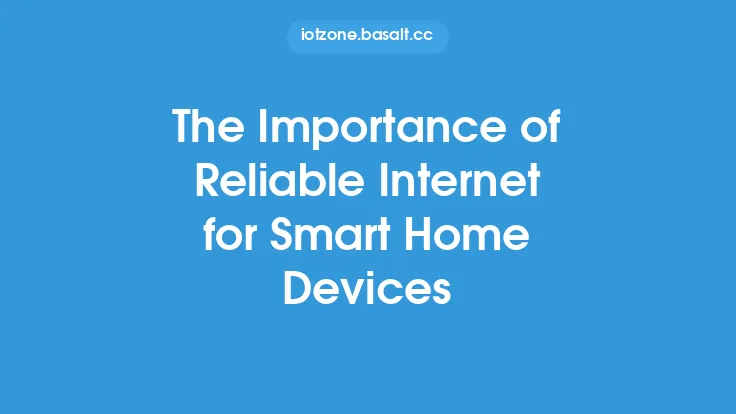The increasing number of devices connected to the internet has led to a growing need for reliable and efficient network management. The Internet of Things (IoT) has brought about a new era of interconnected devices, and with it, a plethora of challenges related to network connectivity. IoT network management is crucial for ensuring that devices can communicate with each other and with the cloud or other external systems. In this article, we will delve into the importance of IoT network management for reliable connectivity and explore the key aspects of managing IoT networks.
Introduction to IoT Network Management
IoT network management refers to the process of monitoring, controlling, and maintaining the network infrastructure that connects IoT devices. This includes managing device connections, data transmission, and network performance. Effective IoT network management is essential for ensuring that devices can communicate with each other and with the cloud or other external systems. It involves a range of activities, including network planning, device provisioning, and performance monitoring. IoT network management also involves ensuring that the network is secure, scalable, and reliable.
Key Challenges in IoT Network Management
IoT network management poses several challenges, including device heterogeneity, scalability, security, and quality of service (QoS). Device heterogeneity refers to the diversity of devices connected to the IoT network, each with its own unique characteristics and requirements. Scalability is another challenge, as IoT networks need to be able to support a large number of devices and handle increasing amounts of data. Security is a major concern, as IoT devices are often vulnerable to cyber threats and attacks. QoS is also a challenge, as IoT applications require low latency and high throughput to function effectively.
Importance of IoT Network Management
IoT network management is critical for ensuring reliable connectivity and enabling IoT applications to function effectively. It helps to ensure that devices can communicate with each other and with the cloud or other external systems, and that data is transmitted efficiently and securely. Effective IoT network management also helps to prevent network congestion, reduce latency, and improve overall network performance. Additionally, it enables real-time monitoring and control of devices, which is essential for many IoT applications, such as industrial automation and smart cities.
Network Management Protocols and Technologies
Several network management protocols and technologies are used in IoT network management, including Simple Network Management Protocol (SNMP), Network Configuration Protocol (NETCONF), and RESTful APIs. These protocols and technologies enable network administrators to monitor and control devices, configure network settings, and troubleshoot issues. Other technologies, such as software-defined networking (SDN) and network functions virtualization (NFV), are also being used to manage IoT networks. SDN and NFV enable network administrators to create virtual networks and deploy network functions, such as firewalls and routers, in a flexible and scalable manner.
IoT Network Management Architecture
The IoT network management architecture typically consists of several layers, including the device layer, network layer, and application layer. The device layer includes the IoT devices themselves, which are connected to the network layer. The network layer includes the network infrastructure, such as routers, switches, and gateways, which enable devices to communicate with each other and with the cloud or other external systems. The application layer includes the IoT applications, which run on top of the network infrastructure and provide services such as data analytics and device control.
Best Practices for IoT Network Management
Several best practices can be followed to ensure effective IoT network management, including network planning, device provisioning, and performance monitoring. Network planning involves designing and configuring the network infrastructure to meet the requirements of IoT applications. Device provisioning involves configuring and deploying devices on the network, and ensuring that they are properly authenticated and authorized. Performance monitoring involves tracking network performance metrics, such as latency and throughput, and troubleshooting issues as they arise. Other best practices include implementing security measures, such as encryption and access control, and ensuring that the network is scalable and reliable.
Future of IoT Network Management
The future of IoT network management is likely to involve the use of artificial intelligence (AI) and machine learning (ML) to automate network management tasks and improve network performance. AI and ML can be used to analyze network data and predict issues before they occur, and to optimize network configuration and performance. Other emerging technologies, such as edge computing and fog computing, are also likely to play a role in IoT network management. Edge computing involves processing data at the edge of the network, closer to the devices, while fog computing involves processing data in the cloud, but closer to the devices than traditional cloud computing. These technologies have the potential to improve network performance, reduce latency, and enable new IoT applications and services.
Conclusion
In conclusion, IoT network management is critical for ensuring reliable connectivity and enabling IoT applications to function effectively. It involves a range of activities, including network planning, device provisioning, and performance monitoring, and requires a range of protocols and technologies, including SNMP, NETCONF, and RESTful APIs. Effective IoT network management is essential for preventing network congestion, reducing latency, and improving overall network performance, and for enabling real-time monitoring and control of devices. As the IoT continues to grow and evolve, the importance of IoT network management will only continue to increase, and new technologies and approaches will be needed to meet the challenges of managing complex IoT networks.





